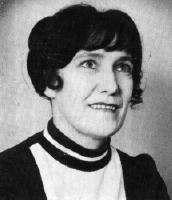 |
| |||||
 AV Sellwood & Peter Haining Devil Worship in Britain Corgi, London, 1964 (price: 3/6; 128 pages)     
|  Ernest de Martino Magic: Primitive and Modern Tom Stacey, London, 1972 (price: 60p; 224 pages)     
| |||||
 Gelie Duncan Living Witchcraft Horwitz, Melbourne, 1970 (price: 70c; 128 pages)     
|  Francis King Ritual Magic NEL, London, 1972 (price: 40p; 176 pages)     
|  Doreen Irvine From Witchcraft To Christ Concordia, London, 1973 (price: 60p; 192 pages)     
| ||||
|
Recently the Church of England proudly produced figures showing that church attendances had risen slightly over the last couple of years, but no one was fooled. Blips aside, Christianity has been in steady decline in Britain for about a hundred and fifty years now. And frankly there's more chance of Christ himself coming back than the congregations. For which, of course, we're truly grateful. What concealed that long-term decline for many years was the social aspects of the ritual. It was in 1917 that Maude Royden first remarked that the Church of England was the Conservative Party at prayer, but the reason the aphorism remained in use was the striking fact that both institutions were without overt ideology: just fifty years ago the Conservatives could claim more members than any other party in Western Europe, but those members were not asked to make any contribution to the development of policy, nor did they ask to be so allowed. Everyone knew that Tories weren't interested in politics, nor Anglicans in religion - both institutions existed primarily, secondarily and even tertiarily (sorry!) as social organizations. When the cosily symbiotic relationship started to break-up so spectacularly in the 1960s - under the twin onslaught of Harold Wilson and the Bishop of Woolwich, welded together in the white heat of the theological revolution - it was the Church that suffered the most. The Tories went on to reinvent themselves, first as Selsdon and then as Essex Man, but the Church of England just floundered around helplessly and embarrassingly. And as it did so, the newspaper coverage of its decline was matched in column inches only by the rise in stories about witchcraft. Just to be clear, when the British media talks about witchcraft, it has no interest whatsoever in unpicking the subtleties of Wicca, the Druids, Satanism, Voodoo or whatever - it's all grist to the mill, and it's all the same stuff. As far as the tabloids can see, they all sacrifice goats and abuse children. So what we've got here is a collection of paperback cash-ins exploring the alleged 'phenomenon' of modern witchcraft. The volumes by Ernest de Martino and Gelie Duncan at least pretend to explore the beliefs of those who might call themselves witches (in however confused a form), whilst Francis King is a serious historian and student and doesn't really deserve to be included here. The real joys, however, are in the books by Sellwood & Haining and by Doreen Irvine. The former is like a News of the World 'exposé' spun out to over a hundred pages, whilst the latter is an hysterically over-the-top yarn of a worker in the sex industry who goes on to accept Jesus into her heart as her Saviour and feels obliged to make the transition even more extreme than it was. I have seen Ms Irvine's descriptions of her activities cited as being the origin of the absurd tales of Satanic child-abuse that the likes of Bea Campbell made money from in the 1980s and '90s, which would obviously make her a deeply evil person - but I'm inclined to think that somebody would have peddled that sort of rubbish anyway. The road from Sellwood & Haining could only lead downwards.
home | ||||||
